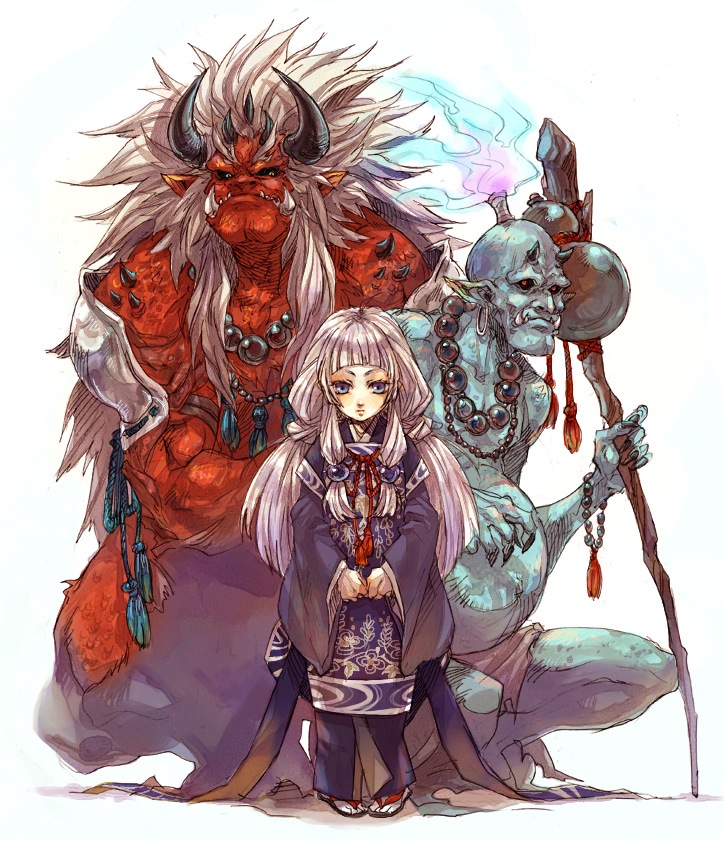

In Japan, it tells the same story in the historical and official handiwork ordered by the Emperor some centuries later, a specter invited also to the court and it occured many rituels of Shinto for making it to be disappeared. The oldest writing about the Yokai dates back to the ancient China, in the 1st century, when the Emperor testifies the appearance of a specter in the imperial court. The most general definition is the appearance of an inexplicable thing that beyond human comprehension. In Shimane, it looks like a crab with the body of an ox, while in Shikoku, the ushi-oni has tusks and flying squirrel-like wings.

Ushi-oni generally appear on beaches and attack people who walk there. The folklore describes more than one kind of ushi-oni, but the depiction of a bovine-headed monster occurs in most. This mysterious yokai is depicted differently depending on the region. The Ushi-Oni (, Ox Oni (demon)), or gyki, is a ykai from the folklore of western Japan. They were also called as mononoke, which means "a supernatural being" as well as the kanji 妖 “yo” of Yokai is translated to the "calamity" or the mystery. Ushi-Oni (ox demon) is one of the mythical monsters that once haunted Japan and particularly terrorized fishermen out in the sea. The revised web novel changed them to Ushi-oni, because Takeru Nezaki thought that it would be good to put out Ushi-oni because the cow and spider joined forces.Before they appear in the films of any recent works or pieces, the Yokai: creatures, gohsts, animals, demons, ogres or any other monsters of Japanese folklores have been already present in the books before the Middle Ages. In the original Narou version, Atlanacha had golems. Takahashi draws inspiration from Japanese folklore and yokai (a class of supernatural monster, spirit or demon in Japanese mythology). Most Ushi oni resemble an ox from the head up and a demonic horror below. They mainly appear at beaches and attack people who walk on beaches. They have illustrated the desires, the fears and the different world visions. There are various kinds of ushi-oni, all of them some sort of monster with a horned, bovine head. It is most often encountered in the coastal waters of western Japan, particularly in Shimane prefecture, where it is feared for its vicious attacks on fishermen. Though she was once a fearsome youkai who attacked humans. 'cow devil') is a malevolent sea monster with the head of a bull and the body of a giant spider or crab. Ushi-oni ( 牛鬼, Ushi-oni ?) is a yōkai which appears in the folklore of the western part of Japan. Urumi Ushizaki (, Ushizaki Urumi) is an ushi-oni who runs a fishery at the Sanzu River. Contents 1Description 2Legends by area 2. Ushi-onigenerally appear on beaches and attack people who walk there. However the Ushi-oni were quickly disposed by Kuroki. The Ushi-Oni (, Ox Oni(demon)), or gyki, is a ykaifrom the folkloreof western Japan.1 The folklore describes more than one kind of ushi-oni, but the depiction of a bovine-headed monster occurs in most.

An Oni (demon) at the gate of Todaiji, the worlds largest wooden building. Definition: The term Oni comes from the Kanji and commonly means in Japanese demon or devil. Atlanacha summons the Ushi-oni to attack Rena. Find the perfect oni demon stock photo, image, vector, illustration or 360. Lavurys provided minotaur soldiers to Atlanacha, to help her look for Rena. Discover more posts about japanese mythology, japanese folklore, tw:spiders, creatures. Kuroki sense magical powers from Ushi-oni, and their fighting power seemed quite high. See a recent post on Tumblr from allmythologies about ushi-oni.

Their power is quite strong as they descended from the Violence God. They can use Invisible: Disappear ( 姿消し インビジブル, Sugata keshi Inbijiburu ?) magic. The tip of the spider leg is like a sharp knife. Ushi-Oni ():-Demon cows that often appear in Japanese folklore to scare humans out of their fields and eat them. The head is a cow, but the body is similar to a spider. Kuroki sense no reason from Ushi-oni's eyes.


 0 kommentar(er)
0 kommentar(er)
